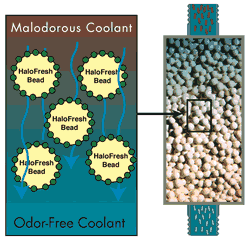Get The Smell Out-Extend Coolant Life
In many metalworking shops, the useful life of coolant is cut short by offensive odors.
Share



In many metalworking shops, the useful life of coolant is cut short by offensive odors. When the smell gets too bad, a common method of dealing with the issue is to dump the coolant and replace it with new.
Generally, the smell of the coolant becomes offensive long before the coolant ceases to be effective. Shops are wasting money by dumping the coolant sump because of rancidity before the coolant needs replacement for performance reasons.
Compounding the costs associated with wasting good coolant are the disposal costs of getting rid of it. Increasing the useful life of coolant has a direct savings on the cost of manufacturing by reducing the purchase cost of the coolant itself and reducing the fees associated with coolant disposal.
A new coolant treatment process developed by Vanson Halosource, Inc. (Redmond, Washington) uses chlorine to neutralize the source of offending coolant odors and, as a result, doubles the useful life of coolant. Called HaloFresh Coolant Extender, the system works with any coolant pump/sump system with up to 200 gallons capacity.
In operation, the coolant is drawn from the machine’s sump by a self-contained, 4 to 6 gpm electric or pneumatic pump and initially passes through a mesh pre-filter to remove large particles. The coolant is then routed through a halogen treatment chamber, which is loaded with chlorinated bead bags. The system works with any water-miscible fluids including soluble, synthetic and semi-synthetic.
Continuous exposure to these chlorine beads removes the odor from the coolant by a chemical reaction. The coolant emerges from the chamber odor-free and in compliance with all federal guidelines for disposal.
The key to this is process a technology that binds the chlorine to the polystyrene beads. The chemical bond between the chlorine and the polystyrene is strong enough that no free chlorine is released into the coolant using the process. Instead, an ionic exchange between the chlorine and hydrogen sulfide—the usual source of rancid odors—results in an oxidation process that neutralizes the odor.
Tests conducted by a third party research lab (TechSolve, Cincinnati, Ohio) showed no change in the machinability characteristics of treated coolants. Another advantage of this system is an overall cleaner machine tool, which reduces the incidence of dermatitis and other contact health problems.
In most applications, a ratio of 1 gram of the chlorinated beads per 1 gallon of coolant is sufficient to remove the odor from the coolant. The bead bags are effective for about 1 month. Payback for the system, considering a halving of the number of coolant dumps, is about 1 year.


















